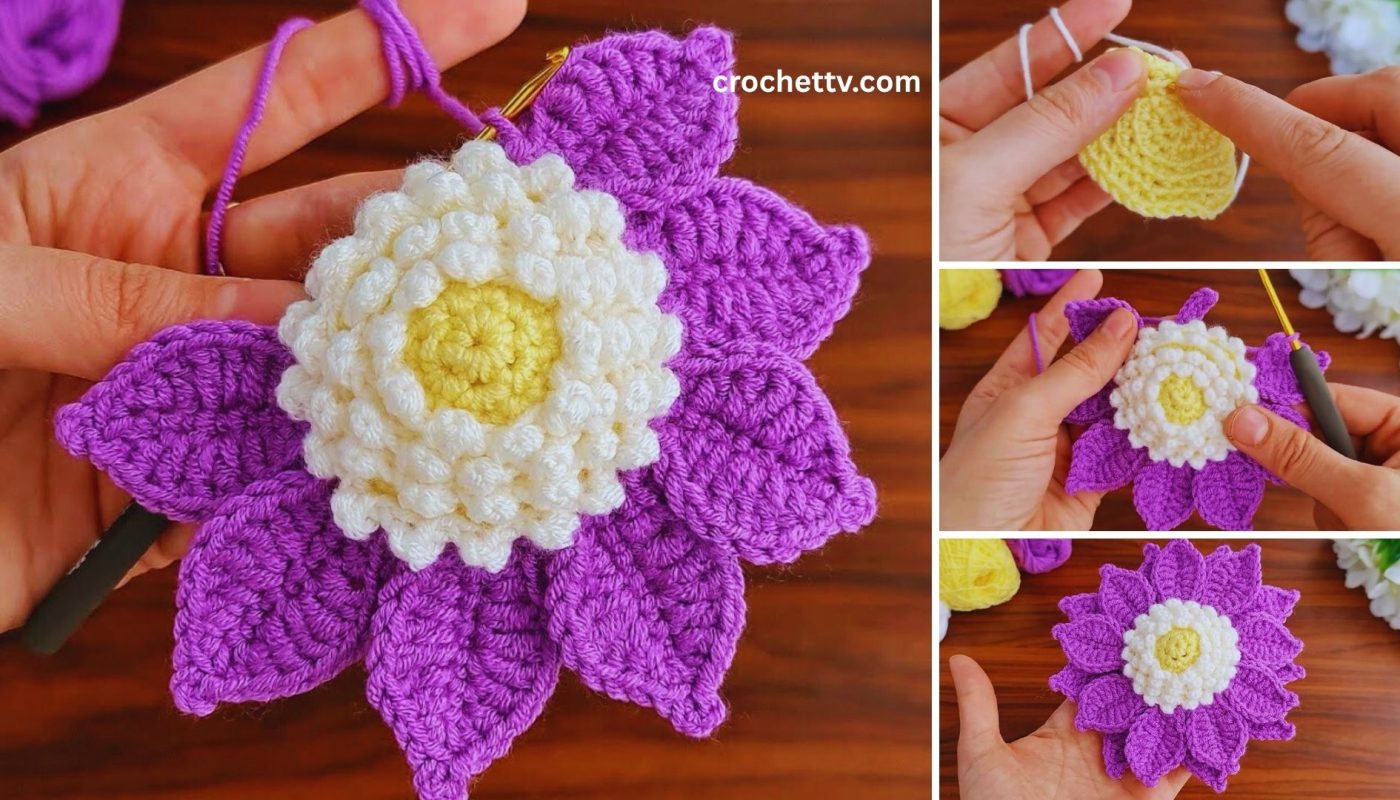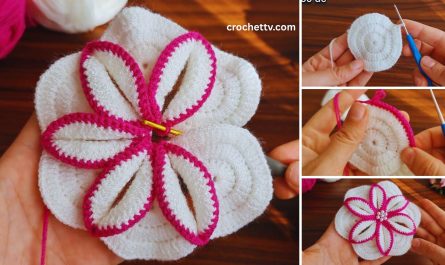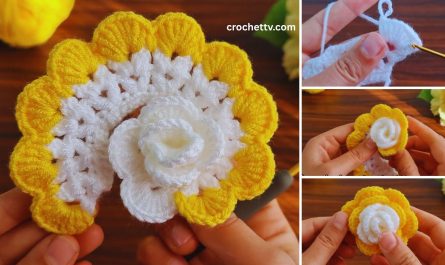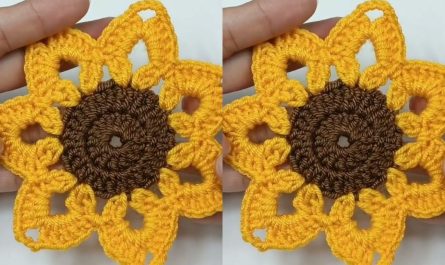Let’s crochet a stunning and intricate 3D flower using three vibrant colors! This tutorial is designed for crocheters who are ready to take on a more layered and dimensional project. You’ll learn how to build up multiple tiers of petals, strategically using three different yarn colors to create a truly eye-catching and realistic bloom that pops with depth and texture. These 3D flowers are fantastic for embellishing hats, bags, blankets, or even as stand-alone decorative pieces for home decor or special occasions.
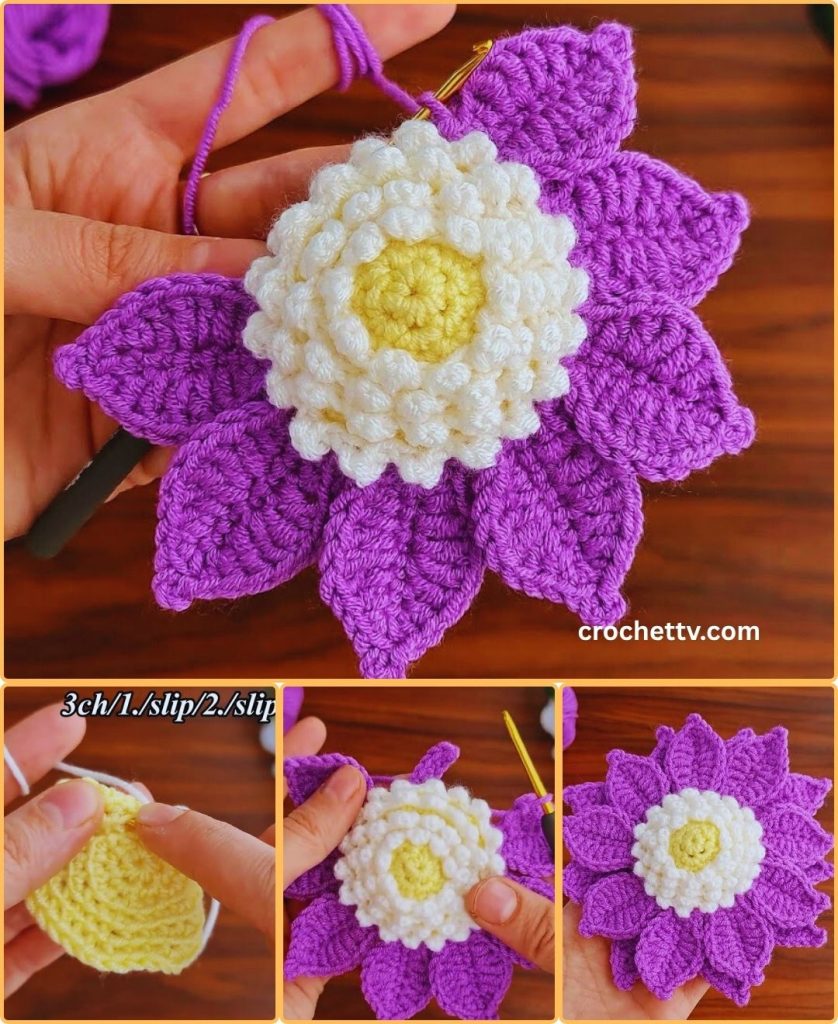
How to Crochet a 3D Flower with Three Colors (Step-by-Step Tutorial)
This detailed guide will walk you through making a beautiful, multi-layered, textured flower. We’ll focus on creating distinct dimensions and showcasing your chosen colors beautifully through smart stitch placement.
Skill Level: Intermediate
This project is ideal if you’re comfortable with:
- Chain (ch): The basic foundation stitch.
- Slip Stitch (sl st): For joining rounds and neatening.
- Single Crochet (sc): A dense stitch.
- Half Double Crochet (hdc): A stitch taller than single crochet.
- Double Crochet (dc): A common, taller stitch.
- Triple/Treble Crochet (tr): A taller stitch, used for larger petals.
- Magic Ring (MR) / Chain-2 Start: For a neat center hole.
- Working in rounds: Crocheting in a circular manner.
- Color changes: Neatly switching between yarn colors.
- Working into specific stitches/spaces (e.g., behind stitches, front loops only, back loops only): These techniques are crucial for the 3D effect.
- Fastening off: Securing your yarn.
- Weaving in ends: The essential finishing touch.
Finished 3D Flower Dimensions (Approximate):
Using worsted weight yarn and the suggested hook, your finished 3D flower will typically measure around 3.5-5 inches (9-12.5 cm) in diameter, depending on your tension and how much you fluff the petals.
Materials You’ll Need:
Gathering your materials beforehand ensures a smoother crocheting experience.
- Yarn: Approximately 25-40 yards (23-37 meters) of Worsted Weight (Medium #4) Yarn.
- Color A (Center): This will be the innermost color of your flower (e.g., yellow for a classic center, or a contrasting neutral like cream or light brown).
- Color B (Mid-Layer/Base): This color will form the first foundation layer, often a slightly darker or complementary shade to your outer petals (e.g., a darker pink, coral, or light green if you want to suggest sepals).
- Color C (Outer Petals): This will be the main, vibrant color for your most prominent, outer petals (e.g., a bright pink, red, deep purple, or classic white).
- Crochet Hook: Size H/5.0mm. This hook size works well with worsted weight yarn to create a nice stitch definition and texture.
- Yarn Needle (Tapestry Needle): Essential for seamlessly weaving in all your loose yarn tails. It has a blunt tip and a large eye, making it easy to thread yarn through.
- Scissors: Any sharp pair of scissors for cutting your yarn.
Understanding the 3D Flower Construction: Multi-Layered Petals
This 3D flower is built in distinct, progressively larger layers, using specific stitch placement to create depth and dimension.
- Center Core (Color A): You’ll start with a small, flat circle in your first color.
- Inner Petal Base (Color B – BLO): The next round, in your second color, will be worked into the back loops only of the previous round. This is key, as it leaves the front loops of the stitches free for attaching the outermost petal layer later.
- Inner Petal Layer (Color B): You’ll then immediately create your first, smallest set of petals into the stitches of the current round.
- Outer Petal Base (Color C – Front Loops): You’ll then work into the front loops that you left unworked from Round 1. This creates a new foundation behind your current petals.
- Outer Petal Layer (Color C): Finally, you’ll create your largest, most prominent petals into the spaces created in the previous step, pushing the inner petals forward for a dramatic 3D effect.
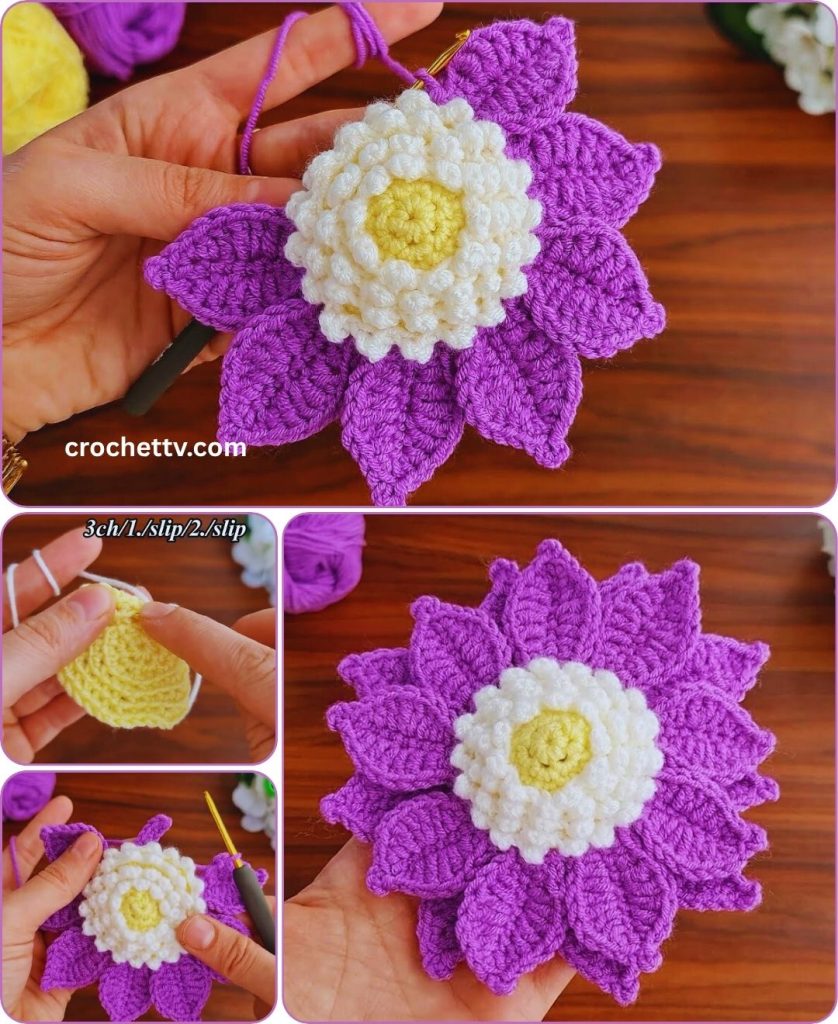
Let’s Crochet Your 3D Flower!
Follow these steps carefully. The key to a beautiful 3D flower is understanding where to place your hook for each layer and maintaining consistent tension. Take your time, especially with locating the correct loops.
Part 1: The Flower Center (Color A)
We’ll start with the very middle of your flower, forming a neat, flat circle.
- Starting with Color A:
- Begin with a slip knot and place it onto your H/5.0mm crochet hook.
- Magic Ring (MR) Start: Create a magic ring. This makes a nice, tight center.
- (Alternative start if Magic Ring is tricky): Chain 4, then slip stitch (sl st) into the first chain to form a small ring.
- Round 1: Chain 2 (ch 2 – counts as your first half double crochet (hdc)). Work 9 more half double crochet (hdc) stitches into the center of the ring. You’ll have 10 hdc stitches total.
- (If using Chain-4 start): Work 10 hdc stitches into the center of the chain-4 ring.
- If using a magic ring, gently pull the tail tightly to close the center hole.
- Slip stitch (sl st) into the top of the beginning Chain 2 to join the round.
- Fasten off Color A, leaving a 4-inch (10 cm) tail for weaving in.
Part 2: Inner Petal Layer (Color B)
This round creates the first layer of petals. You’ll also lay the groundwork for the outer petals by working into back loops only.
- Join Color B:
- Join Color B yarn with a slip stitch (sl st) into any hdc stitch from Round 1.
- Round 2 (Inner Petals & BLO foundation):
- Chain 1 (ch 1 – does NOT count as a stitch).
- Work 2 single crochet (sc) stitches into the back loop only (BLO) of the same stitch where you just joined (the top of the hdc stitch where you attached Color B).
- Work 2 sc into the BLO of each remaining hdc stitch around the round. You’ll have 20 sc stitches total.
- Important: Working into the back loop leaves the front loop of each stitch visible on the right side of your work. These 20 front loops from Round 1 are crucial – you will work into them later for your very outer petal layer!
- Slip stitch (sl st) into the first single crochet stitch you made at the beginning of this round to join.
- Do NOT fasten off Color B yet! You’ll use this color for the inner petals directly.
- Round 3 (Creating Inner Petals – still with Color B):
- Chain 1 (ch 1 – does NOT count as a stitch).
- *In the next stitch (the first sc of Round 2): Work (Chain 2, 2 double crochet (dc), Chain 2, slip stitch). This forms one petal.
- Skip the next single crochet stitch from Round 2.
- Slip stitch into the next single crochet stitch from Round 2.*
- Repeat from * to * around the round. You should create 10 petals evenly spaced.
- Tip: The “skip 1, sl st into next” ensures you have enough stitches for 10 petals (20 sc stitches / 2 stitches per petal = 10 petals).
- After the 10th petal, slip stitch one last time into the very first slip stitch you made when starting this petal round (Round 3), to really secure the round.
- Fasten off Color B, leaving a 4-6 inch (10-15 cm) tail for weaving in.
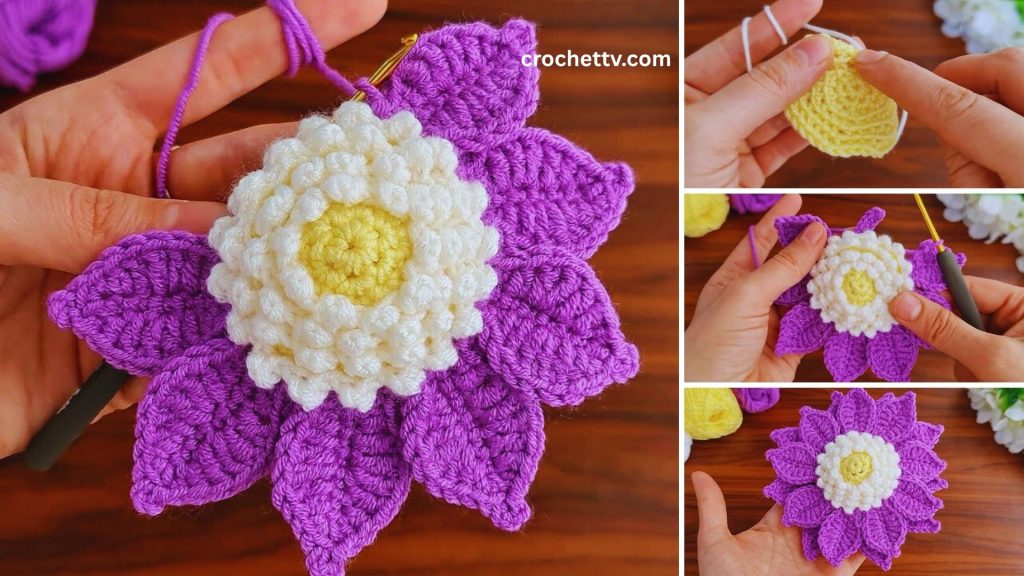
Part 3: Outer Petal Layer (Color C)
This is where the true 3D effect comes in! You’ll create a second, larger layer of petals behind the first layer, using the front loops you left unworked from Round 1.
- Join Color C:
- Turn your flower over slightly so you can clearly see the unused front loops from Round 1 (the 10 hdc stitches). These loops are the foundation for your outer petals.
- Join Color C yarn with a slip stitch (sl st) into any of these unused front loops from Round 1.
- Round 4 (Large Petals – working into front loops of Round 1):
- *In the same unused front loop where you just joined: (Chain 4, 1 double crochet (dc), 1 triple/treble crochet (tr), 1 double crochet (dc), Chain 4, slip stitch). This forms one larger, fuller petal.
- Skip the next unused front loop from Round 1.
- Slip stitch into the next unused front loop from Round 1.*
- Repeat from * to * around the round. You should create 5 petals in this layer. You have 10 front loops from Round 1, and each petal sequence uses 2 front loops (one to work into, one to skip).
- Tip: This might feel a little awkward at first as you’re working “behind” the previous petals. Be patient and take your time to locate the correct front loops. The “Chain 4” at the beginning and end of the petal shell creates a taller, more open petal.
- After the 5th petal, slip stitch one last time into the very first slip stitch you made when joining Color C, to really secure the round.
- Fasten Off:
- Cut your yarn, leaving a 4-6 inch (10-15 cm) tail.
- Yarn over with your hook, pull the cut tail completely through the loop left on your hook, and gently tug to secure the knot.
Part 4: Final Finishing Touches
- Weave in All Ends:
- This is crucial for a neat, durable, and professional-looking 3D flower. You’ll have tails from your starting ring, all your color changes, and the final fasten-off.
- Thread each yarn tail onto your yarn needle.
- Carefully weave the tail into the stitches of the same color on the back of your flower. Go in one direction for a few stitches (about 1-2 inches / 2.5-5 cm), then subtly change direction (e.g., weave back through some of the same stitches diagonally or perpendicularly) to “lock” the tail in place and prevent it from unraveling.
- Trim any excess yarn close to the fabric, being careful not to cut any of your actual stitches.
- Fluff and Shape:
- Gently use your fingers to fluff and arrange the petals. Push the inner (Color B) petals forward and let the outer (Color C) petals spread out to enhance the beautiful 3D effect. The layers should be distinct and vibrant.
- Blocking (Optional):
- While not as critical as for flat pieces, light blocking can help even out tension and define the petal shapes. Gently mist with water and let air dry, shaping with your fingers as it dries. Avoid pinning too tightly, as you want to maintain the beautiful 3D quality.
Congratulations! You’ve successfully crocheted a beautiful and intricate 3D flower with three colors! This project is a fantastic way to expand your crochet skills by tackling more complex layering and precise stitch placement. Your finished flower is now ready to add a gorgeous, textured, and colorful accent to any of your crochet creations or stand alone as a stunning decorative piece.

